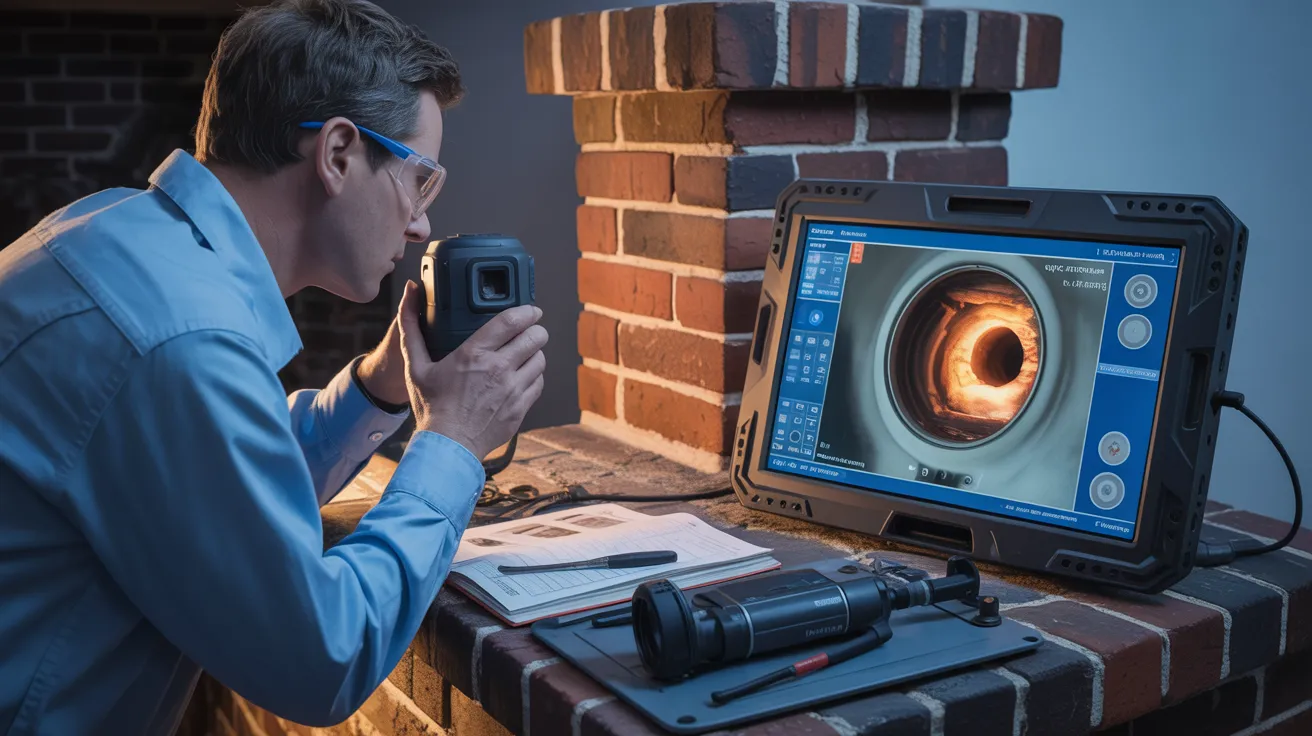When you need quick and professional chimney repair in Seattle, you must address red flags including crumbling mortar, dampness issues, or poor smoke ventilation. Immediate attention helps avoid dangerous conditions and expensive structural issues frequently seen in Seattle's damp weather. Depend on qualified specialists for complete evaluation, leak detection, masonry repair, and moisture protection—all meeting approved techniques and safety protocols. Be preventive; regular inspections and prompt repairs safeguard your home's efficiency and integrity. Explore essential advice and specialist insights to preserve your chimney next.

Critical Findings
Warning Signs Your Chimney Requires Repair
Although your chimney appears intact from the outside, certain indicators might suggest underlying problems that compromise safety and efficiency. Pay close attention to indoor smoke problems, as this often points to problems with your chimney's ventilation system. Significant soot deposits inside the chimney or at the fireplace opening suggests poor airflow and increased fire risk. You could observe a lingering, powerful smell—this often means creosote or soot is building up, impeding normal ventilation. Deteriorating masonry, unstable bricks, or noticeable fractures suggest structural deterioration that may rapidly deteriorate without attention. Through careful observation of these signs, you'll maintain your chimney's safe function and lower the chance of safety issues. Schedule a professional inspection when you notice any issues.
Typical Chimney Concerns in Seattle Properties
In Seattle's humid climate, chimney deterioration often accelerates and introduces distinct upkeep problems for homeowners. Water penetration causes brick spalling, mortar deterioration, and rust formation on metal components. Without consistent chimney maintenance, soot and creosote accumulate quickly due to the area's persistent precipitation and cool temperatures, increasing the risk of blockages and fire hazards. You might also spot efflorescence—white staining—on your chimney, indicating water infiltration. Broken or absent chimney caps allow rain and debris to enter, additionally weakening structural integrity.
A thorough flue inspection is crucial because continuous moisture promotes mold and compromises the flue liner, posing risks for venting exhaust and gases. Resolving these typical issues with regular chimney cleaning and detailed flue inspection maintains your Seattle home's chimney efficient and secure.
The Importance of Timely Chimney Repairs
Addressing chimney problems quickly allows you to stop costly structural damage that may affect your home's integrity. You'll also reduce fire risk by removing hazards including creosote buildup along with masonry cracks. Timely repairs ensure your chimney functions efficiently, improving both indoor comfort and energy consumption.
Avoiding Structural Issues
When moisture penetrates into your chimney structure, it accelerates brick deterioration, compromises joint integrity, and affects structural soundness. Left untreated, tiny fractures widen, permitting additional water seepage and resulting in major repair expenses or even structural failure. Periodic cleaning allows you to identify these issues early, removing debris that can retain dampness on internal surfaces. Checking and upkeeping your flue lining is essential, as damaged linings expose masonry to corrosive byproducts and further water infiltration. By taking prompt action, you avoid freeze-thaw cycles from creating brick damage and mortar to crumble. Addressing minor damage now prevents complete restoration later. Prioritize professional assessments to maintain your chimney's integrity, safety, and performance for years. Immediate care protects your home's structure and peace of mind.
Preventing Fire Risks
If your chimney develops structural damage, crumbling mortar, or loose bricks, it may rapidly turn into a significant fire hazard. Structural defects and openings allow hazardous embers and heat to seep into adjacent combustible structures, raising the likelihood of a house fire. To preserve optimal chimney safety, you must have quick repairs to address these problems and restore the chimney's integrity. Fixing problems right away guarantees that flammable creosote cannot collect in hidden spaces, additionally lowering the risk of fire. In addition, compromised chimney liners can allow toxic gases to leak into your home, adding to safety hazards. Don't wait for small issues to worsen; quick, professional repair is crucial for proper fire safety and long-term peace of mind in your Seattle home.
Optimizing Home Efficiency
Although chimney damage usually looks minor at first, even tiny fissures or spaces can significantly affect your home's energy effectiveness. When your chimney develops problems, conditioned air escapes, requiring your climate control system to work harder. This not only raises your monthly expenses but furthermore adds excessive strain on your climate control unit. Regular chimney maintenance, along with regular chimney cleaning, guarantees your fireplace functions at optimal efficiency and prevents costly energy leakage.
If you're thinking about installing a new fireplace, it's important to tackle present chimney problems. Compromised masonry or defective flue liners could diminish the performance of modern fireplaces, decreasing their cost-saving potential. When you repair your chimney promptly, you'll preserve a pleasant indoor environment, realize energy savings, and maintain your home's systems function effectively and securely.
Understanding the Chimney Repair Process
We'll begin with a thorough evaluation and damage analysis to identify structural problems or safety hazards in your chimney. When problems are discovered, you can select the most appropriate repair solutions, from stonework renovation to chimney liner installation. Each step prioritizes both the security and stability of your home.
Damage Inspection and Evaluation
Before any repairs can begin, a thorough inspection and damage assessment is crucial for a safe and effective chimney repair process. You'll need a qualified professional to inspect your chimney from top to bottom, looking for deterioration, cracks, and loose bricks. Special consideration is given to chimney soot buildup, which can conceal underlying damage and pose safety concerns. The inspection includes investigating flue blockages, which could prevent proper ventilation of dangerous fumes and affect your home's air quality. With professional tools and cameras, they'll investigate concealed sections, looking for signs of water infiltration, corrosion, or pest infestations. With a comprehensive report of problem areas, you'll gain a clear understanding of areas needing work, ensuring all repairs fix underlying issues—not just surface symptoms.
Essential Repair Techniques Overview
When the inspection discovers key concerns, the restoration work can proceed with focused fixes aimed to bring back safety and performance. Professionals begin with complete soot removal to eliminate dangerous deposits and improve airflow. If your chimney liner shows damage, they'll recommend either relining or replacing it to prevent hazardous emissions from infiltrating living spaces and to protect masonry from heat damage. Deteriorated masonry require tuckpointing or brick replacement to preserve the chimney's structural integrity. Water-resistant applications may be applied to prevent future moisture penetration. For major problems, complete or partial reconstruction could be necessary. Each restoration method works to resolve the root causes, ensuring your chimney remains safe, efficient, and compliant with Seattle's building codes.
Chimney Leak Detection and Solutions
Even though chimney leaks often remain undetected until they produce visible damage, early detection is essential to preventing expensive structural damage and health concerns. Watch out for key signs including water marks on walls or ceilings near your chimney, musty or damp smells, and oxidized firebox elements. Professional chimney leak detection involves a complete inspection of the flashing, crown, and cap to locate moisture entry points. Specialists use specific tools to assess concealed moisture and structural vulnerabilities. Once detected, established leak repair solutions—including applying new flashing seals, installing new chimney caps, or applying waterproofing agents—can successfully resolve the problem. By tackling leaks promptly, you'll safeguard your home from mold development, compromised masonry, and continued water issues, guaranteeing enduring chimney performance and safety.
Brick Repair and Masonry Services
When you spot brick damage or deterioration on your chimney, prompt masonry repair is essential to ensure structural soundness and prevent hazardous conditions. Compromised masonry elements allow moisture to infiltrate, leading to rapid deterioration and risk of breakdown. You should seek a professional expert to assess the extent of damage, making sure the right masonry restoration techniques are used. During repair work, technicians carefully remove deteriorated units, match the new units for your chimney, and utilize superior bonding materials for a perfect restoration. This comprehensive approach not only enhances aesthetic quality but also protects from further structural issues. Don't delay addressing these issues—addressing masonry problems early will prolong chimney durability and protect your property from associated risks.
Professional Chimney Cap and Crown Services
The chimney cap and crown serve as your chimney's primary defenses against water intrusion and animal entry, their condition directly impacts your home's safety and the flue's longevity. Should your cap be damaged, rusted, or absent, water can seep down the flue, resulting in interior deterioration and likely mold issues. A secure, securely mounted chimney cap also stops wildlife, refuse, and rodents from obstructing your venting system. The chimney crown protects the top of your masonry, protecting bricks and mortar from freeze-thaw cycles and erosion. Cracks or spalling in the crown enable moisture to penetrate, threatening structural integrity. Periodic examinations and prompt maintenance of both the chimney cap and chimney crown ensure you maintain a safe, efficient, and long-lasting chimney system.
Choosing the Right Chimney Service Provider
Finding a qualified chimney repair company demands careful evaluation of qualifications, safety protocols, and specialized skills. You need to ensure that the service provider possesses proper licensing, coverage, and accreditations from respected industry bodies. Question them regarding their experience with both chimney servicing and complex venting configurations to ensure they can handle your system's specific needs. Professionals must adhere to current safety guidelines, employ protective equipment, and follow strict guidelines to eliminate incidents or fire dangers. Evaluate their history by verifying references and reading customer feedback centered on dependability and expertise. It's also essential to confirm that they employ industry-approved supplies and techniques for all repairs. By emphasizing these aspects, you'll ensure your chimney repair job is executed properly, productively, and to the highest technical specifications.
Key Maintenance Guidelines for Your Chimney
Make sure to get routine chimney inspections to detect structural issues and safety concerns at an early stage. Prevent creosote deposits by following recommended check here cleaning intervals and using exclusively well-dried wood. It's also crucial to use appropriate waterproofing and sealing to safeguard your chimney from Seattle's frequent rain.
Routine Chimney Maintenance
While many property owners tend to ignore it, arranging routine chimney inspections is essential for keeping a reliable and properly functioning fireplace system. It's important to have your chimney checked once every year by a qualified expert who can spot structural issues, blockages, or signs of wear. Regular checks are crucial in ensuring fireplace safety by revealing potential issues before they worsen. A complete inspection will additionally assess if a cleaning service is required to clear buildup or blockages that could impede proper ventilation. Qualified inspectors employ specialized tools and cameras to evaluate the entire chimney system, providing a detailed evaluation. By prioritizing regular inspections, you'll defend your home against possible dangers, extend the lifespan of your chimney, and ensure your fireplace functions efficiently.
Preventing Creosote Buildup
Multiple key preventative maintenance procedures can greatly reduce the risk of creosote buildup in your chimney. Make sure to burn seasoned hardwood, as it yields less smoke and decreases residue. Verify that your fireplace damper is completely open during operation to optimize airflow, which helps with efficient combustion and decreases creosote formation. Schedule professional chimney sweeping at least once a year—creosote removal by a certified technician is critical to prevent dangerous accumulations. Inspect your firebox and flue routinely for early signs of buildup, such as dark, tar-like deposits. Tackle these promptly to avoid a serious fire hazard. Refrain from overloading the firebox or burn unapproved materials, as both can hasten creosote buildup. Maintaining these procedures will help keep your chimney safer and more efficient.
Waterproofing & Sealing Solutions
Why does water infiltration pose such a significant threat to your chimney's integrity? As moisture penetrates your masonry, it often results in serious damage, crumbling bricks, and corroding metal parts. Dampness breaks down mortar connections and provides perfect conditions for freeze-thaw deterioration, weakening the entire system. To protect against these damaging effects, prioritize proper waterproofing and sealing.
Commence with a comprehensive assessment for gaps and cracks that can enable water penetration. Then, apply a professional-grade sealant coating particularly made for chimneys—avoid using generic water repellents, as they might retain moisture. Ensure the sealant is moisture-permeable, permitting the chimney to "breathe" while blocking rain penetration. Routinely apply sealant every few years to preserve maximum protection. This proactive step prolongs your chimney's life and maintains your home safe.
Booking Your Chimney Inspection and Maintenance
To prevent escalating damage and safety hazards, book a professional chimney inspection and repair service. A certified specialist will inspect the complete setup, spotting possible dangers such as venting problems or pressing maintenance needs. Make sure to address these important matters—creosote accumulation or clogs can create dangerous fire conditions or cause dangerous carbon monoxide to leak into your home.
Schedule your chimney inspection yearly, or when extreme weather occurs, to verify your chimney's safety and efficient operation. During the assessment, specialists utilize specialized instruments to assess flue linings, masonry, and chimney caps, delivering comprehensive advice for any necessary maintenance work. By taking preventive measures, you'll prevent major damage, ensure proper air quality, and maintain your heating system runs efficiently all season long.
Popular Questions
What Are the Average Costs for Seattle Chimney Repairs?
As you consider chimney repair in Seattle, you can anticipate to pay ranging from $300 for basic maintenance to $3,000 or more for major restoration. You'll want to schedule a chimney inspection first—professionals can identify hidden issues and guarantee safety. Chimney cleaning generally runs $150–$350 and may reveal maintenance requirements. Be sure to employ certified technicians; they'll utilize correct tools and approaches to ensure household protection and keep your chimney operating properly.
Are Permits Required for Seattle Chimney Repairs?
Don't assume permits are only needed for big construction projects! In Seattle, you'll need a permit for the majority of chimney repairs, specifically those involving structural modifications or masonry work. Regular chimney cleaning and inspection services need to meet conformity to local codes to guarantee safety. Always check with Seattle's Department of Construction and Inspections, because skipping permits could lead to serious problems, failed inspections, or safety risks for your property and loved ones.
Is It Safe to Use Your Fireplace While Repairs Are in Progress?
Refrain from using your fireplace during repair work. To maintain fireplace safety, wait for all repair work is complete and fully inspected. Using your fireplace during repair work can create risks of fire dangers, harmful gases, or structural issues. Maintain clear communication with your contractor about repair scheduling and confirm when it's safe to begin using again. Putting safety first helps your fireplace to perform optimally and safely and keeps safe your family and property.
Will Your Homeowners Insurance Pay for Chimney Repairs?
Think of insurance coverage as being similar to a protective shield—it guards you from unexpected events, but not regular deterioration. Your home insurance policy might pay for chimney repair when damage is caused by an insured event, including storm damage or fire. It won't cover problems due to lack of maintenance or wear and tear. To begin the claim process, document the damage thoroughly and contact your insurer promptly. Always prioritize safety by having a certified professional assess your chimney's condition.
What's the Expected Timeline for a Standard Chimney Repair?
A normal chimney repair generally spans one to three days, according to the level of damage identified during your chimney inspection. When only minor masonry work is required, you'll experience shorter turnaround times. Major restoration projects, including sectional rebuilding, could increase the duration. You must focus on safety by booking a professional inspection initially, as this guarantees all structural and ventilation issues are addressed thoroughly before any masonry restoration or other repairs begin.
Summary
Don't wait until your living room appears like something out of Seattle's own version of "Old Faithful"—with water and soot spewing from your neglected chimney. The warning signs are there, you know the risks, so reach for your phone rather than a mop. Focus on safety and efficiency by arranging a professional inspection today. With skilled service and sharp eyes, you'll keep your home dry, your air clean, and your chimney from starring in its own disaster film.
 Michael Oliver Then & Now!
Michael Oliver Then & Now! Kenan Thompson Then & Now!
Kenan Thompson Then & Now! Gia Lopez Then & Now!
Gia Lopez Then & Now! Samantha Fox Then & Now!
Samantha Fox Then & Now! Catherine Bach Then & Now!
Catherine Bach Then & Now!